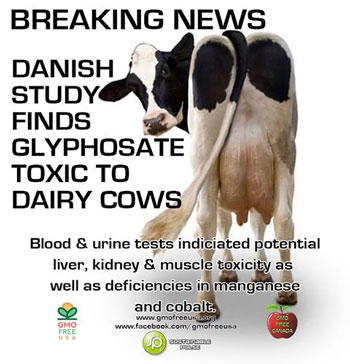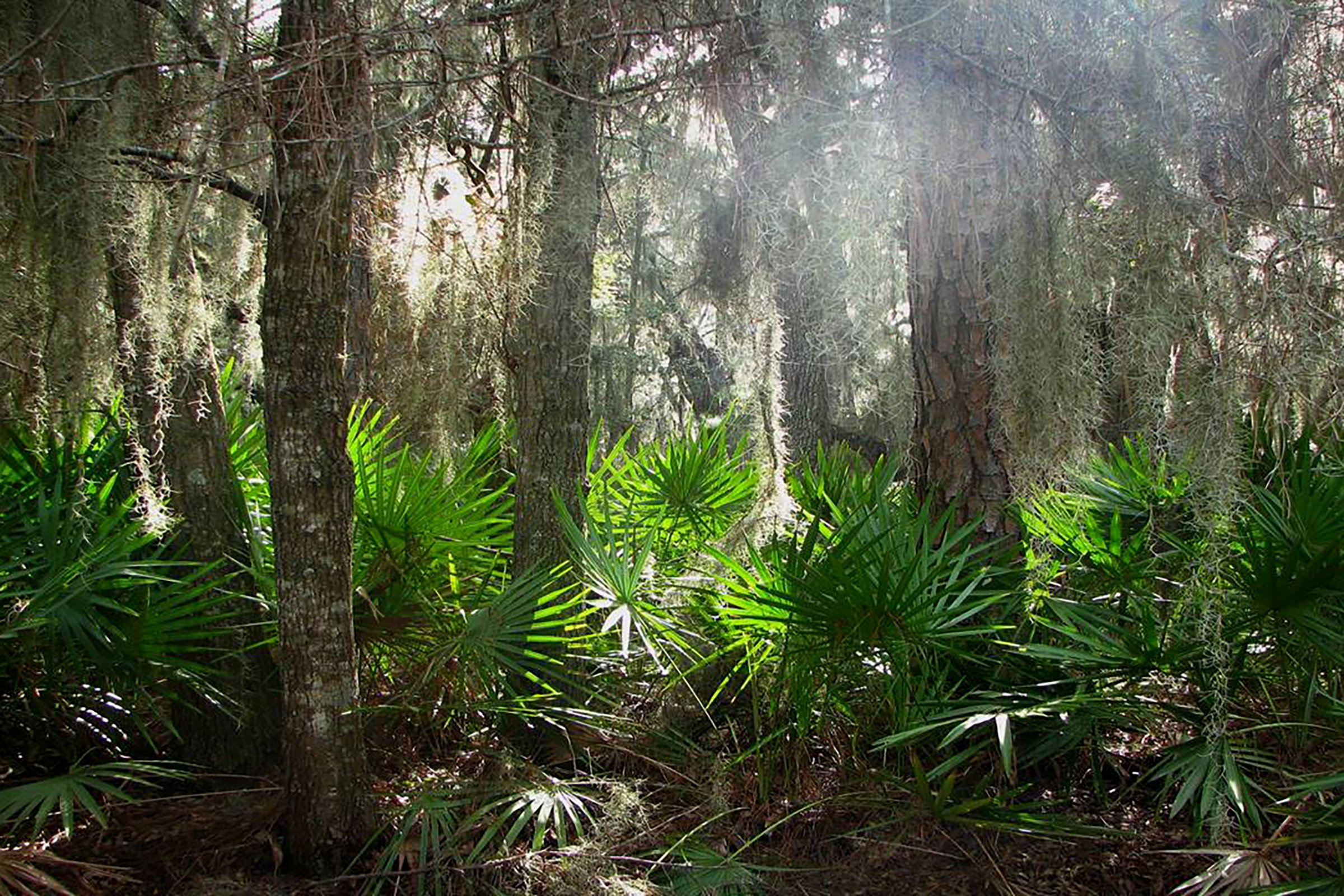ew study reveals toxic levels of glyphosate in dairy cows
A new study published in the Journal of Environmental & Analytical Toxicology reveals that the active ingredient of Monsanto’s best selling herbicide ‘Roundup’ is found in all the dairy cows that were used for the test.
Dr. Monika Kruger and her colleagues investigated the excretion of glyphosate in the urine of 30 cows from 8 different Danish farms. The investigative team looked at blood serum parameters indicative of cytotoxicity as alkaline phosphatase (AP), glutamate dehydrogenase (GLDH), glutamate oxaloacetate transaminase (GOT), creatinine kinase CK), nephrotoxicity, (urea, creatine) and cholesterol in each of the urine samples. They also looked at trace minerals such as manganese (Mn), cobalt (Co), selenium (Se), copper (Cu) and zinc (Zn).
The results concluded that different levels of glyphosate were excreted in the urine of all cows and glyphosate had a significant impact on blood parameters of cows. In fact, the researchers found that increased levels of GLDH, GOT and CK in cows could possibly show the effect of glyphosate on liver and muscle cells. They also discovered that high urea levels in some farms could be due to nephrotoxicity of glyphosate.

In conclusion the researchers discovered that “correlations between glyphosate and some of the measured blood serum parameters to CK (R= 0.135), Se (R=-0.188), Co (R= -0,403) and Zn (R=0,175) demonstrate that glyphosate is toxic to the normal metabolism of dairy cows.”
Keep in mind that glyphostae in Monsanto’s Roundup have been linked to many chronic diseases including cancer, birth defects and infertility. Click here to find out why Monsanto’s Roundup is more toxic than what the majority believe.
Milk is anything but ‘wholesome’, despite all the claims by the main stream media and big dairy industry:
According to many scientific research and studies, increase in consumption of red meat and dairy products can increase risk of chronic diseases such as cardiovascular disease and different kinds of cancer. Click here to find out a diet high in red meat, eggs and dairy products can increase the risk of different cancers.
So what’s the best replacement for milk and dairy products?
Dairy-free organic coconut milk or organic almond milk (from real food sources, not synthetic ones that have artificial sweeteners and additives) are good replacement for milk. Keep in mind that even raw milk or goat milk can become contaminated in a number of ways, especially in large commercial farms that put profit before safety. Therefore, it’s safer to buy raw milk or goat milk from small local farmers that are highly conscious since their entire families drink the milk they produce.
Can lack of milk or dairy products cause osteoporosis and ratio of calcium to magnesium:
Many people might still believe that dairy products are necessary for healthy bones. However, the recent studies suggest that the ratio of calcium to magnesium is an important factor to health and vitality including healthy bones. As a matter of fact, 60% of the magnesium in your body is stored in bones and magnesium plays an important role in absorption of calcium and vitamins. But, 80% of Americans have magnesium deficiency and most Americans have very high ratio of calcium to magnesium (more like 6 to 1).
Many studies have concluded that the problem Western diet is high calcium intake (especially for women who are going through menopause and are at high risk of osteoporosis) without sufficient amount of magnesium.
The recommended dietary ratio of calcium to magnesium happens to be 2 to 1, however, the current research suggests that the ratio of calcium to magnesium should be more like 1 to 1.
In fact, studies show that high dietary intake of calcium and lack of Magnesium and vitamin D can increase in rate of cardiovascular diseases and strokes.
You can get your natural calcium and magnesium from food sources such as seeds, nuts, carrots, cauliflower, raw cacao beans, cabbage, broccoli and real herbal extracts (Plant based calcium with magnesium).
There is a growing recognition on the part of conscientious consumers about the sources of the botanical products they purchase, both in regard to where their favorite herbs come from and how their own purchasing behaviors impact environmental sustainability. This increasing awareness that there are people and places tied to every item we buy involves not just knowing where a botanical comes from, but also acknowledging the context in which it is harvested.
Forest Farming vs. Wildharvesting
In America’s forests, wildharvesting has long been the way that people sourced valuable woodland botanicals like ginseng, black cohosh, and goldenseal. Now, however, the available supply of these non-timber forest products (NTFPs) is being augmented through intentional propagation, a practice known as “forest farming.” Through a combination of direct plantings of forest botanicals and the tending of existing plant populations to improve their numbers and viability, woodland agriculture offers the promise of much greater control over the stewardship of botanical sites and the quality of the botanicals cultivated on them. Not only does forest farming provide a clear, consistent supply chain, it also empowers consumers to play an active role in supporting the future of threatened species, ecosystems, and communities.
Forest Farming in Appalachia
Many woodland botanicals are sourced and harvested in Appalachia, in areas that have long been economically stressed. Historically, the true wealth of the region—the “green capital” of the trees and plants growing throughout its forests—has not necessarily been channeled into the hands of the people who live there. But now, with the greater recognition on the part of consumers and companies as to how raw materials are sourced, forest farming and its inherent promise of better prices may provide an avenue toward environmentally focused economic development in the region.
Saw palmetto is cultivated for eventual selective harvest within the boundaries of one southern Appalachian forest farm. (Photo credit: Eric Burkhart)
The Challenges of Forest Farming
One of the most obvious up-front challenges facing this budding industry is the time lag inherent to cultivating slow-growing perennial woodland plants. A forest farm established today will likely not render a saleable harvest for four to six years. Uncertainty about how to support operations during this waiting period, as well as how the market may change over time, can make the initial investment seem like a risky proposition for landowners and other people interested in forest farming, especially those with already limited financial resources.
Additionally, because woodland agriculture is not well defined or long established, forest farmers do not yet have access to some of the basic, critical support structures that the government has put into place for field farmers: for example, insurance. Best practices for these systems are also still in their formative stages, imparting an experimental and uncertain quality to these new agricultural endeavors. This shortage of economic and educational support systems presents difficult hurdles for those interested in investing in forest farming.
While these practical challenges are important and undeniable, they are also inevitable to any new industry and can be overcome over time through research and experience. The greatest challenges are the directional ones that lie ahead, those which will shape the industry for generations to come.
Forest farmers tend to a crop of ramps, a delicious wild onion variety native to Appalachia, within the plants' natural setting.
We know that the market for NTFPs is substantial, since the demand for them has sustained a sizeable independent wildharvesting industry for generations. But because the wild collection of NTFPs has long been seen as recreational and of little consequence and value in the worldwide herb market, generations of these traditional suppliers have been marginalized. As we move forward with forest farming, it is imperative that we build in systems to ensure that these wildharvesters are able to access new opportunities and possibilities. And as interest in intentional forest farming grows throughout the region, we must enable new and existing systems of production to move forward together, building a reputation for traceability, sustainability, and integrity that benefits the entire agroforestry market, from producers to consumers.
Supporting Forest Farming with Mountain Rose Herbs
Allies like Mountain Rose Herbs and United Plant Savers have been leaders in the burgeoning forest farming movement and are actively helping to formulate a process that balances environmental sustainability with economic development and social justice—bringing together the people, the plants, and the products to create better outcomes for all three.
By buying these botanicals at higher price points and demonstrating how this kind of economic development could pay off, Mountain Rose Herbs is helping to define the next steps for the entire herbal products industry, namely, by providing solid evidence that environmental sustainability can be a sound and responsible business practice. Through the purchase of forest-farmed, forest-grown products, they have shown that it is possible to grow this industry.
Furthermore, their willingness to commit to being long-term customers for sustainable forest botanicals helps absorb some of the risks new Appalachian forest farmers face, which aligns with Mountain Rose Herbs’ own mission to help forge a better future for the region’s people and plants.











